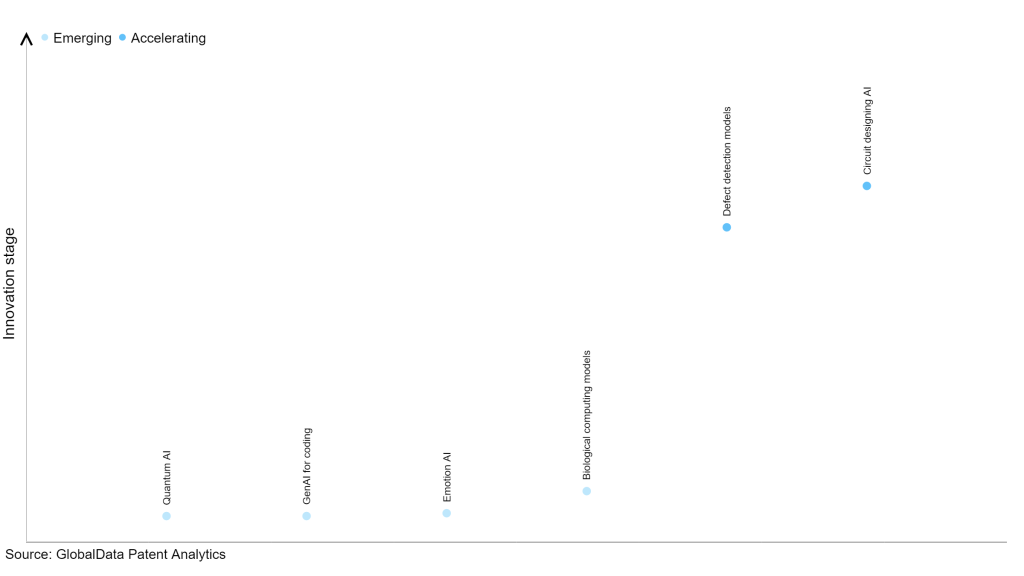The technology industry continues to be a hotbed of patent innovation. Activity is driven by a demand for more accurate and efficient simulations across diverse sectors, including gaming, automotive, architecture, and healthcare, and growing importance of technologies such as generative adversarial networks (GANs), reinforcement learning and convolutional neural networks (CNNs). In the last three years alone, there have been over 1.5 million patents filed and granted in the technology industry, according to GlobalData’s report on Artificial intelligence in technology: 3D model simulation. Buy the report here.
However, not all innovations are equal and nor do they follow a constant upward trend. Instead, their evolution takes the form of an S-shaped curve that reflects their typical lifecycle from early emergence to accelerating adoption, before finally stabilizing and reaching maturity.
Identifying where a particular innovation is on this journey, especially those that are in the emerging and accelerating stages, is essential for understanding their current level of adoption and the likely future trajectory and impact they will have.
185+ innovations will shape the technology industry
According to GlobalData’s Technology Foresights, which plots the S-curve for the technology industry using innovation intensity models built on over 1.6 million patents, there are 185+ innovation areas that will shape the future of the industry.
Within the emerging innovation stage, quantum AI, GenAI for coding and emotion AI are disruptive technologies that are in the early stages of application and should be tracked closely. Biological computing models, defect detection models, and circuit designing AI are some of the accelerating innovation areas, where adoption has been steadily increasing.
Innovation S-curve for artificial intelligence in the technology industry

3D model simulation is a key innovation area in artificial intelligence
3D model simulation encompasses generating and manipulating a virtual three-dimensional entity or setting to replicate real-world situations, assess designs, or simulate manufacturing procedures.
GlobalData’s analysis also uncovers the companies at the forefront of each innovation area and assesses the potential reach and impact of their patenting activity across different applications and geographies. According to GlobalData, there are 250 companies, spanning technology vendors, established technology companies, and up-and-coming start-ups engaged in the development and application of 3D model simulation.
Key players in 3D model simulation – a disruptive innovation in the technology industry
‘Application diversity’ measures the number of applications identified for each patent. It broadly splits companies into either ‘niche’ or ‘diversified’ innovators.
‘Geographic reach’ refers to the number of countries each patent is registered in. It reflects the breadth of geographic application intended, ranging from ‘global’ to ‘local’.
Patent volumes related to 3D model simulation
Source: GlobalData Patent Analytics
Among the companies innovating in AI in 3D model simulation, International Business Machines (IBM) is one of the leading patents filers. The company’s patents are aimed at a method for manufacturing integrated circuits (ICs). The method involves receiving a design layout of an IC, which incorporates a primary feature. A correction process is then applied to this main feature, resulting in a modified version. Using a computer, a simulated outline of this modified main feature is generated, comprising numerous data points. In computer-readable format, a variety of supplementary data is produced, with each set containing at least one process performance metric linked to a specific data point. Both the simulated contour and the supplementary data are retained for utilization in subsequent stages of the process, such as mask production, mask examination, mask rectification, wafer direct inscription, wafer assessment, and wafer rectification. The other prominent patent filers in the space include Taiwan Semiconductor Manufacturing and Siemens.
In terms of application diversity, Taiwan Semiconductor Manufacturing leads the pack, while Siemens and Samsung Group stood in the second and third positions, respectively. In terms of geographical reach, DIRTT held the top position, followed by Altium and Stratasys.
The integration of AI in 3D model simulation enables the creation of highly realistic and interactive virtual environments, allowing for accurate testing and validation of designs and scenarios before physical implementation. It reduces the cost and time associated with traditional prototyping and testing processes.
To further understand the key themes and technologies disrupting the technology industry, access GlobalData’s latest thematic research report on Artificial Intelligence (AI).
Data Insights
From

The gold standard of business intelligence.
Blending expert knowledge with cutting-edge technology, GlobalData’s unrivalled proprietary data will enable you to decode what’s happening in your market. You can make better informed decisions and gain a future-proof advantage over your competitors.







